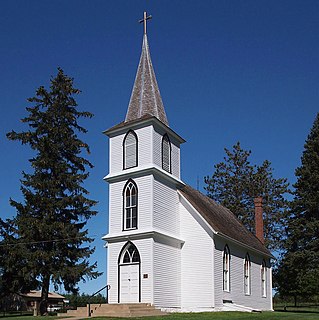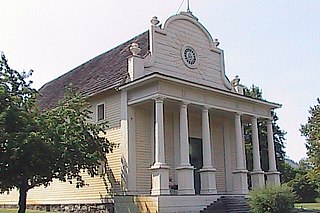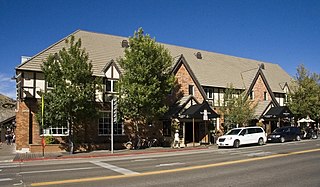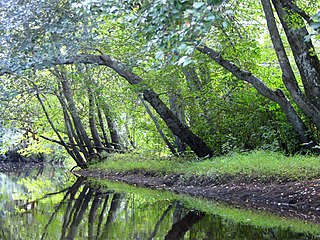
Troy is a city in the U.S. state of New York and the seat of Rensselaer County. The city is located on the western edge of Rensselaer County and on the eastern bank of the Hudson River. Troy has close ties to the nearby cities of Albany and Schenectady, forming a region popularly called the Capital District. The city is one of the three major centers for the Albany Metropolitan Statistical Area (MSA), which has a population of 1,170,483. At the 2010 census, the population of Troy was 50,129. Troy's motto is Ilium fuit. Troja est, which means "Ilium was, Troy is".
Aspetuck is a village, which in Connecticut is an unincorporated community on the Aspetuck River, in Fairfield County, Connecticut, mostly in the town of Easton but extending also into Weston. It is significant for being the location of the Aspectuck Historic District, a well-preserved collection of houses from the 18th and 19th centuries. The area was settled in the 17th century. It was a long-time home of Helen Keller. According to a New York Times real estate section article, "The district gets its name from the Aspetuck Indians, who lived along the river. In 1670, they sold the land to English settlers for cloth, winter wheat and maize valued at $.36." Weston was incorporated in 1787, and Easton was split out and incorporated in 1845.

Cordelia Lutheran Church was dedicated by Pastor Peter Carlson on December 15, 1883 and is the oldest Lutheran building in the state of Idaho. The church was built on property given by Andrew Olson in the Lenville, Idaho area to serve the Swedish Lutheran families in the area. In 1919, the building ceased to be used for regular church services. The building and surrounding 31 acres (13 ha) is currently owned and administered by a non-profit group named Friends of Cordelia. The building is used for weddings, picnics, socials, concerts and Easter Sunrise service by area residents.

The Mason Cornwall House is located in Northern Idaho at 308 South Hayes Street in Moscow, Idaho. The residence is a Victorian Italianate style house constructed of brick with a stucco finish. It is architecturally significant as one of the finest houses of its period in this area. The Cornwall house is listed on the National Register of Historic Places. It is currently used as a private dwelling.

Christdala Evangelical Swedish Lutheran Church is a historic church located in Forest Township, Rice County, Minnesota. It is situated 11 miles (18 km) west of Northfield at 4695 Millersburg Blvd.

Bishop Hill Colony is a historic district in Bishop Hill, Illinois. Bishop Hill was the site of a utopian religious community which operated as a commune. It was founded in 1846 by Swedish pietist Eric Janson and his followers. The community was named Bishop Hill after the parish of Biskopskulla in Uppland, Sweden.

Coeur d'Alene's Old Mission State Park is a heritage-oriented state park in North Idaho, preserving the Mission of the Sacred Heart, or Cataldo Mission, national historic landmark. The park contains the church itself, the parish house, and the surrounding property. Built 1850–1853, Mission of the Sacred Heart is the oldest standing building in Idaho. It was designated a National Historic Landmark in 1961, and put on the National Register of Historic Places in 1966.

Thomas Leavitt House, a brick house built in the nineteenth century in Bunkerville, Nevada, United States, is listed on the National Register of Historic Places.

The Wort Hotel was built in downtown Jackson, Wyoming, United States by brothers John and Jess Wort, who were significant figures in the transformation of the economy of Jackson Hole from ranching to tourism. The somewhat Tudor-style building was the first luxury hotel in Jackson. The two-story building features brick facing, with half-timbering and stucco on the second floor and a series of gables facing the street.

Jefferson Prairie Settlement was a pioneer colony of Norwegian-Americans located in the Town of Clinton, in Rock County, Wisconsin. This site and the nearby Rock Prairie settlement outside Orfordville, Wisconsin served as centers for both Norwegian immigration and developments within the Evangelical Lutheran Church in America. The unincorporated community of Bergen, Rock County, Wisconsin is in the vicinity of Jefferson Prairie Settlement.

Peter Peterson Farmstead, also known as Emel Peterson Farmstead, near Waverly, Nebraska, United States, dates from 1893. It was listed on the National Register of Historic Places in 1980.

Chesterfield is a ghost town in Caribou County, Idaho, United States. It is located in Gem Valley at an elevation of 5,446 feet (1,660 m). The community includes a cemetery and former buildings of The Church of Jesus Christ of Latter-day Saints such as a former meeting house, amusement hall and tithing house.

Batsto Village is a historic unincorporated community located on CR 542 within Washington Township in Burlington County, New Jersey, United States. It is located in Wharton State Forest in the south central Pine Barrens, and a part of the Pinelands National Reserve. It is listed on the New Jersey and National Register of Historic Places, and is administered by the New Jersey Department of Environmental Protection's Division of Parks & Forestry. The name is derived from the Swedish bastu, bathing place ; the first bathers were probably the Lenni Lenape Native Americans.

The Thomas Kirby House in Kendrick, Idaho was built in 1889 and modified in 1910 and otherwise. It was built for Thomas Kirby, a man highly responsible for the railroads that started in Kendrick and went to Troy, Idaho.

The Peter Axel Johnson House at 1075 N. 100 East in Pleasant Grove, Utah was built in 1876. It includes both Greek Revival architecture and Scandinavian pair-house architecture. The house is a one and half story stone house. It was built by Peter Axel Johnson, a Mormon who emigrated from Sweden.

The Crittenden Farm is a historic farm-and-ranch complex in far northern Ashland County, Ohio, United States. Once home to an internationally prominent sheep farmer, the complex includes some of the region's most distinctive agricultural architecture as well as scattered pieces of land that have seen almost no changes since the area was first settled. It has been named a historic site because of its place in the area's history.

The Helvig–Olson Farm Historic District is an agricultural historic district located in rural Clinton County, Iowa, United States, 3 miles (4.8 km) southwest of the town of Grand Mound. It was listed on the National Register of Historic Places in 2000.

The Nels Severson Barn, also known as "Fort" Severson, is a historic barn located north of Carpenter in rural Mitchell County, Iowa, United States. It is a two-story structure composed of irregularly-cut limestone with a gable roof. Its walls are 18 inches (46 cm) thick. It is one of a few, and possibly the only, stone structure in the area. The barn was built by Norwegian immigrant Nels Severson in 1867. He and his brother Ole were early settlers in this region. Local tradition refers to the building as a fort. Its large size and sturdy construction would protect the white settlers from Indian attacks. It is also said that it was a stop on a stage coach line. While the latter might be true, there is no evidence to corroborate either tradition. The barn was listed on the National Register of Historic Places in 1977.

The Philip and Anna Parrish Kirchner Log House is a historic building located north of Peterson, Iowa, United States. The Kirchners moved from the Albany, New York area to southwest Clay County in 1867, and built this log house the same year. It is located on part of the property that his older brother A.J. "Gust" Kirchner claimed in 1856. They were among the first Caucasian settlers in the county. A summer kitched was later added to the west side of the house and a blacksmith shop onto the north side. The Kirchners lived here until they built a two-story frame house nearby in 1882. Philip's sister, Charlotte Kirchner Butler, bought the property after his death and restored the log house to its original condition around 1910, which meant the removal of the summer kitchen and the blacksmith shop. The property remained in the family until at least the 1990s, and housed a display of family artifacts. The house was listed on the National Register of Historic Places in 1993.

The Axel Bohman House, at 116 N. Main St. in Troy, Idaho, was built in 1914. It was the home of one of three brothers who immigrated from Sweden.



















